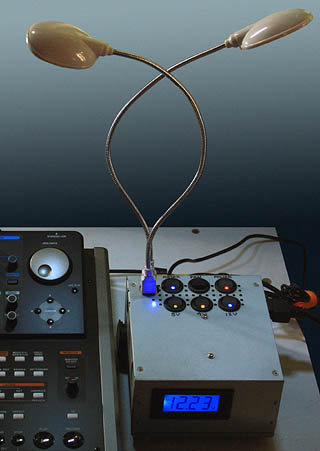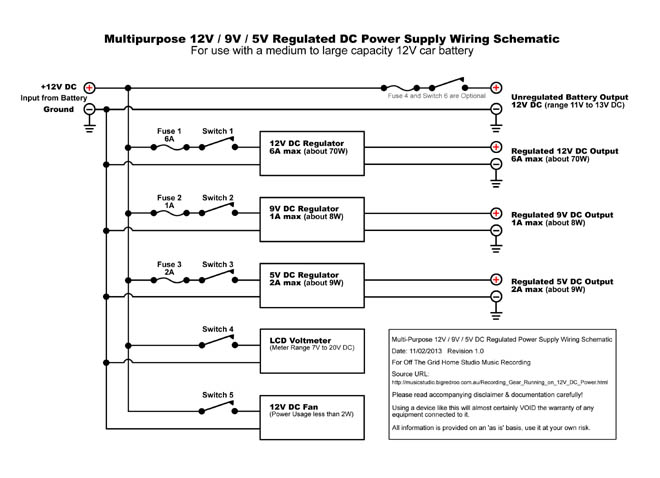This page provides information for the creation of a D.I.Y. (Do-It-Yourself) Multipurpose 12V DC Power Supply. Visitors are advised they use the information provided on this page at their own risk. The owners of this web site accept no liability and/or responsibility for the manner in which visitors employ the provided information, including but not limited to any injury, loss of data, damage to equipment and/or financial loss incurred as a result thereof.

The Problem with Mains Powered
Audio and Recording Gear
One of the intrinsic problems with Mains Power is the inherent noise that it introduces into all electrical equipment. Most noticeable or obvious is mains 'hum', which is a result of the frequency of the mains supply itself. This is usually either 50 or 60Hz, depending on the specifications of the country you live in.
A related issue is that all those many meters of mains wiring act as a very effective antenna for all manner of Radio Frequency (RF) signals ranging from Wi-Fi connections, Computers and even Mobile Phones. In a residential area, noise sources may originate from neighbours' properties or even several blocks away. High current machinery or equipment like power tools and welders have a serious impact. This can result in unfiltered domestic mains power outlets transmitting quite a lot of noise to sensitive audio equipment. Mains filters can be used to reduce this problem, however they rarely eliminate it entirely.
It's worth mentioning that even if you are using Off The Grid power (a wind / solar / batteries combination) to generate your own Mains Voltage via an inverter, that inverter will add noise to your power system (even if it is a Pure Sine Wave Inverter). The noise may be somewhat less than with the public mains power supply, but it will still be noisy!
Battery Power as the Solution
For the Noise Problems associated with Mains Power:
The simplest way to eliminate Mains Power related noise in its entirety is to stop using Mains Power. By using DC (Battery) Power to run your audio recording devices you can achieve a Noise Floor that is so low as to be inconsequential for all practical purposes.
For this to work however you need to meet two important criteria. Firstly, you need to have a recording equipment that isn't excessively 'Power Hungry' and
then secondly, you need an adequate DC Power Supply.
The provided schematic shows a relatively simple 12V DC (Car Battery) based power supply that will adequately run a collection of music/recording devices. It provides the following stable regulated output voltages from an input voltage range of 14V down to 10.5V DC, in other words, from a car battery:
- 12V DC at 6A (~70W)
For recording gear like the Tascam DP24 (12W max with phantom power on)
and electronic musical instruments like the Casio WK-7500 (18W)
- 9V DC at 1A (~8W)
For guitar effects & pedals (pay attention to plug polarity, not all FX pedals are the same)
- 5V DC at 2A (~9W)
For LED lighting and charging USB devices (this is a Power Only connection)
Where V = Volts, A = Amperes (Amps), W = Watts (or power) - The relationship is V x A = W.
It's worth noting though that in practical terms, there are usually power losses involved due to some of the electrical energy being lost in the conversion process from one voltage to another (a lot of it as heat). This can easily end up being a Watt or two of power, so keep that in mind before you go connecting a whole heap of devices.
Other Features Include:
- LED Voltage Display to allow Battery Monitoring (Range from 7V to 20V)
- Switched 12V Fan to allow for cooling if required (PC Power Supply Fan)
The Multipurpose 12V DC Power Supply in the schematic (Circuit Diagram) shown below was built using 'off the shelf' parts and components that are readily available on ebay and some miscellaneous bits I had on hand in my workshop. For example: I used a case from a dead PC power supply to house all the electronics. This made for a tight fit, but had the advantage of keeping the whole thing nice and compact.
Multipurpose 12V DC Power Supply Schematic (Circuit Diagram):
A larger version of the circuit schematic can be obtained by clicking on the image below. Another browser window will open displaying a larger JPEG file which you may print and/or save to your computer. Please respect the copyright.
Circuit Notes:
- Using a non-standard power supply for any of your music/recording gear will almost certainly VOID the warranty of any device connected to it.
- Even though this power supply is not working at Mains Voltage, there is still the very real possibly of electrical shock and physical injury. So be careful ... You have been warned!
- Power switches with a built-in LED have been used.
- The Fuses are wired in series before the 5V, 9V and 12V power switches. This way if a fuse blows the switch's LED light will go out. In 99% of cases, an unlit LED will indicate a blown fuse (or no DC power if they are all unlit).
- In the event of a blown fuse ... determine why the fuse blew before replacing it. Fuses are cheaper to replace than your recording gear or effects pedals.
- A switch was considered for addition to the Voltage Meter to allow it to also monitor the Regulated 9V and 12V DC rails. However if the switch is left set on the regulated 12V setting, this may be mistaken for the battery voltage. In this case the battery could run flat and crash your equipment and/or recording project (not a good look). The switch was left out.
- A switch was provided for the 12V DC Fan. The three Voltage Regulators should operate fine in most situations without the fan turned on. If it's actually hot enough to necessitate using the fan, in all likelihood, it will be bordering on too hot to run your recording gear. But ... better to have it, than wish you had it.
- There is a DC pass-through from the Battery Input to a Cigarette Lighter (~12V) output. This allows the connection of ancillary devices like DC-DC power adaptors and/or inverters if required. In hindsight this pass-through power rail could also benefit from the use of a switch. If a fuse is included with the switch it should be rated depending on your expected use from this outlet (4A to 6A suggested). Note that a charged car battery can easily deliver more than 8 Amps ... read as ... more than enough to comprehensively fry most attached electronics.
- RECORDING EQUIPMENT
Recording gear (Tascam DP24) and Keyboards (Casio WK-7500) may need to be (what I call) 'politely shut down'.
This means that each device needs to be powered down via its own Power Button in order for files/settings to be saved. In this case Do Not use the main power switch on the Multipurpose 12V DC Power Supply as a Kill Switch! If you do, you risk losing data and damaging your equipment.
- EFFECTS PEDALS (a.k.a. Stomp Boxes) - Plug Polarity Warning
Be aware that though most pedals run on 9V, the polarity of the connecting plugs may vary.
For example: Both the DP24 and WK-7500 use (what I consider to be) standard power connections, where the outside sleeve is (-) negative (or ground) and the inner sleeve or pin is (+) positive.
However, both of my Zoom guitar effects (GFX 707 & GFX 707 II) are wired with the positive on the outer sleeve. This can be problematic if the power connector makes contact with the power supply case, which will be at ground potential. In other words a short circuit and at least a blown fuse.
ALWAYS check the Polarity of Any Device you are Connecting to a DC Power Supply!
- BATTERIES
Operating time will be dependant on the size/capacity of the battery attached to your power supply. A medium to large car battery is recommended. Let's say your music recording system requires a modest 60W of power.
Using the formula W = V x A ... We get: 60W = 12V x 5A
Knowing this we can estimate that a 50AmpHour battery will be able to provide 5A for 10 hours before depletion. In reality though, car batteries are not designed to be fully depleted (like Deep Cycle batteries) on a regular basis. So a useful working period will probably be around 4 to 5 hours before recharging. A pair of the same batteries in parallel will of course double that working time to 8-10 hours.
Note however that if using more than one battery, the batteries should be identical and purchased as New together, to avoid voltage discrepancies between them. Of course, it will always prove useful to have a spare battery as well.
![]() Part 2 - Multipurpose 12V DC Power Supply - Power Supply Parts & Components
Part 2 - Multipurpose 12V DC Power Supply - Power Supply Parts & Components
Part 3 - Multipurpose 12V DC Power Supply - Power Supply Assembly
Other Links:
[ An Experience with the CASIO WK-7500 ]
[ Capabilities of the CASIO WK-7500 Workstation Keyboard ]
Wizard - 130210

